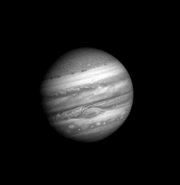The Four Outer Planets
The four outer planets are Jupiter, Saturn, Uranus, and Neptune. Because they are all large planets made either mostly or entirely out of gas, they are often referred to as the “gas giants.” They can also be described as “Jovial planets” as that means similar to Jupiter. (Uranus and Neptune are sometimes referred to as “ice giants,” but don’t be confused, they’re both very, very hot!) Their sizes, in relation to one another, can be seen here:

(This picture does not accurately reflect their distances from one another.)
JUPITER
 The largest planet in the Solar System is Jupiter. As it falls between 740,573,600 and 816,520,800 kilometres from Sol, it’s considered the fifth planet in the Solar System. Jupiter has the volume of 1321.3 Earths, which means that 1321.3 Earths could fit inside of Jupiter! But because Jupiter is made out of gas, it only has the mass of 317.8 Earths. It also has a gravitational pull of 2.53 g-force as compared to the 1 g-force of Earth. It’s impossible to stand on Jupiter because it is gaseous, but if you could stand on it, The largest planet in the Solar System is Jupiter. As it falls between 740,573,600 and 816,520,800 kilometres from Sol, it’s considered the fifth planet in the Solar System. Jupiter has the volume of 1321.3 Earths, which means that 1321.3 Earths could fit inside of Jupiter! But because Jupiter is made out of gas, it only has the mass of 317.8 Earths. It also has a gravitational pull of 2.53 g-force as compared to the 1 g-force of Earth. It’s impossible to stand on Jupiter because it is gaseous, but if you could stand on it,  you would be extremely heavy with that much gravity pulling down on you. The picture on the left shows the size of Jupiter as compared to that of Earth. you would be extremely heavy with that much gravity pulling down on you. The picture on the left shows the size of Jupiter as compared to that of Earth.
The Jovian year is 11.86 Terrestrial years long. In other words, the Earth revolves around Sol 11.86 times in the time it takes Jupiter to revolve around just once. Despite this, the Jovian day is much shorter than ours. Jupiter rotates around its axis every 9.926 hours! That means a Jovian year is 10,475.8 Jovian days long‼
The astronomical symbol for Jupiter is ♃. It has a faint ring system made out of dust. But, it also has no less than sixty-three (63) known moons! The four (4) largest of Jupiter’s moons, discovered by Galileo Galilei b etween 1609 and 1610 and known as the “Galilean moons,” are Io, Europa, Ganymede, and Callisto. etween 1609 and 1610 and known as the “Galilean moons,” are Io, Europa, Ganymede, and Callisto.
The most striking aspect of Jupiter, besides its immense size, is its Great Red Spot. The Great Red Spot is a rotating storm system on Jupiter that’s been raging on for at least at least one-hundred seventy-eight (178) Terrestrial years and possibly as long as three-hundred forty-three (343) Terrestrial years or more! No one knows how long it will last, but we do know that it is the size of two to three Earths. The storm rotates counter-clockwise in about six (6) terrestrial days or fourteen (14) Jovian days.
SATURN
 The sixth planet from Sol is Saturn. It’s between 1,353,572,956 and 1,513,325,783 kilometres from Sol. It is a little smaller than Jupiter, and has the volume of 763.59 Earths. Despite being so large, it has a gravitational pull only slightly larger than Venus’s, and smaller than Earth’s; the pull is 0.914 g-force. Saturn’s density is so small, if it were placed in a huge bathtub of water, it would float! The sixth planet from Sol is Saturn. It’s between 1,353,572,956 and 1,513,325,783 kilometres from Sol. It is a little smaller than Jupiter, and has the volume of 763.59 Earths. Despite being so large, it has a gravitational pull only slightly larger than Venus’s, and smaller than Earth’s; the pull is 0.914 g-force. Saturn’s density is so small, if it were placed in a huge bathtub of water, it would float!
The Saturnian year is twenty-nine and one-half (29½) Terrestrial years long. As Saturn rotates on its axis every ten and two-thirds (10⅔) hours, the Saturnian year is four-thousand seven-hundred seventy-seven (4,777) Saturnian days long.
The astronomical symbol for Saturn is ♄. It has X moons and X rings.
The most interesting thing about Venus is its dense atmosphere. Venus is often called Earth’s “sister planet” because it shares many similarities with Earth, such as a similar size and composition. However, Venus has something our planet does not: a run-away greenhouse effect that keeps Venus extremely hot! The average temperature on Venus is 464º C. (100º C is the temperature at which water boils.) The clouds around Venus are so thick that satellites cannot see through them without entering the atmosphere, and any satellite that does enter the atmosphere quickly melts. Sulphuric acid rains down from these clouds.

Click here to return to the Astronomy Page.
Click here to return to the Kids Coяner.
|